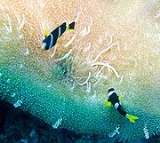
Sebae Clownfish
Encyclopedia
The sebae clownfish, Amphiprion sebae, is a very rare clownfish
found in the northern Indian Ocean
, which includes India
, Sri Lanka
, and the Maldive Islands. They can be very aggressive as they get older, like all damselfish
. They can grow to 12 cm (4.7 inches).
Clownfish
are the most popular species to aquarists. They are the most sought after marine fish. These groups of organisms are classified in a hierarchy and are hermaphrodites. The biggest fish becomes the female and the second biggest becomes the dominant male. The remaining fish are juveniles. This species eat large varieties of meat and vegetable based foods.
Although it is well known for its shared name with the sebae anemone
, it is normally found with the saddle anemone.
and larval rearing of the species Amphiprion sebae. The male starts courting the female a week before they spawn
. The male initiates maintenance of the site chosen for habitation. The female enters the nest to lay her eggs. About 300 to 600 hundred eggs are laid. The males usually guard the eggs, which hatch after six to eight days. The yolk sac of the larvae was small. Between the third and forth day they fed and their body shape changed. On days fifteen to eighteen in their life cycle they enter metamorphosis
.
Clownfish
Clownfish or anemonefish are fishes from the subfamily Amphiprioninae in the family Pomacentridae. Twenty-eight species are recognized, one in the genus Premnas, while the remaining are in the genus Amphiprion. In the wild they all form symbiotic mutualisms with sea anemones...
found in the northern Indian Ocean
Indian Ocean
The Indian Ocean is the third largest of the world's oceanic divisions, covering approximately 20% of the water on the Earth's surface. It is bounded on the north by the Indian Subcontinent and Arabian Peninsula ; on the west by eastern Africa; on the east by Indochina, the Sunda Islands, and...
, which includes India
India
India , officially the Republic of India , is a country in South Asia. It is the seventh-largest country by geographical area, the second-most populous country with over 1.2 billion people, and the most populous democracy in the world...
, Sri Lanka
Sri Lanka
Sri Lanka, officially the Democratic Socialist Republic of Sri Lanka is a country off the southern coast of the Indian subcontinent. Known until 1972 as Ceylon , Sri Lanka is an island surrounded by the Indian Ocean, the Gulf of Mannar and the Palk Strait, and lies in the vicinity of India and the...
, and the Maldive Islands. They can be very aggressive as they get older, like all damselfish
Damselfish
Damselfish comprise the family Pomacentridae except those of the genera Amphiprion and Premnas. They can grow up to long. While most are marine, a few species inhabit the lower stretches of rivers in freshwater. Damselfish usually have bright colors. in tropical coral reefs, and many of those are...
. They can grow to 12 cm (4.7 inches).
Clownfish
Clownfish
Clownfish or anemonefish are fishes from the subfamily Amphiprioninae in the family Pomacentridae. Twenty-eight species are recognized, one in the genus Premnas, while the remaining are in the genus Amphiprion. In the wild they all form symbiotic mutualisms with sea anemones...
are the most popular species to aquarists. They are the most sought after marine fish. These groups of organisms are classified in a hierarchy and are hermaphrodites. The biggest fish becomes the female and the second biggest becomes the dominant male. The remaining fish are juveniles. This species eat large varieties of meat and vegetable based foods.
Although it is well known for its shared name with the sebae anemone
Sebae anemone
The sebae anemone is a species of sea anemone from the northern Indian Ocean, including India, Sri Lanka, and the Maldives. Some species of anemonefishes associate with it, including the Cinnamon , Oman , Orange skunk , Orange , and several more. In contrast, the Sebae clownfish The sebae anemone...
, it is normally found with the saddle anemone.
In the aquarium
They are recommended for first time marine tank owners. When kept in an aquarium a minimum of 20 gallons of water is recommended.Reproduction
A study using estuarine water was done to look at captive breedingCaptive breeding
Captive breedingis the process of breeding animals in human controlled environments with restricted settings, such as wildlife reserves, zoos and other conservation facilities; sometimes the process is construed to include release of individual organisms to the wild, when there is sufficient...
and larval rearing of the species Amphiprion sebae. The male starts courting the female a week before they spawn
Spawn (biology)
Spawn refers to the eggs and sperm released or deposited, usually into water, by aquatic animals. As a verb, spawn refers to the process of releasing the eggs and sperm, also called spawning...
. The male initiates maintenance of the site chosen for habitation. The female enters the nest to lay her eggs. About 300 to 600 hundred eggs are laid. The males usually guard the eggs, which hatch after six to eight days. The yolk sac of the larvae was small. Between the third and forth day they fed and their body shape changed. On days fifteen to eighteen in their life cycle they enter metamorphosis
Metamorphosis
Metamorphosis is a biological process by which an animal physically develops after birth or hatching, involving a conspicuous and relatively abrupt change in the animal's body structure through cell growth and differentiation...
.
External links
- Animal World's Information on the Sebae Clownfish
- http://www.aquariumdomain.com/viewSpeciesMarine.php?id=90

